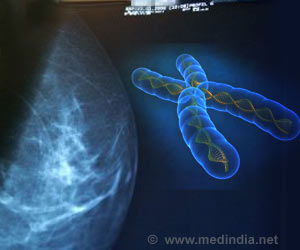A chemical code present on the histones and a protein that coats the DNA determines which genes in that cell are turned on and which are turned off, a new study reveals

"We've been trying to understand both how the different states a cell finds itself in can be defined by the markings on the histones surrounding its DNA, and to find an objective way to define the 'age' of a cell," said Rando, who is also director of Stanford's Glenn Laboratories for the Biology of Aging and deputy director of the Stanford Center on Longevity.
While all cells in a person's body share virtually the same genes, these cells can be as different from one another as a nerve cell is from a fat cell. This is because only a fraction of a cell's genes are actually "turned on" — actively involved in the production of one or another protein. A muscle cell produces the proteins it uses to be a muscle cell, a liver cell produces those it needs in order to be a liver cell and so forth. Rando's team thinks the same kinds of on/off differences may distinguish old stem cells from young stem cells.
In human cells, the DNA in which genes are found doesn't float loose inside the cell nucleus but is, rather, packaged inside protein "husks" called histones. Chemical marks on the histones, which sheathe our chromosomal DNA in each cell's nucleus, act as "stop" and "go" traffic signals. These signals tell the complex molecular machinery that translates genes' instructions into newly produced proteins which genes to read and which ones to skip.
In 2005, Rando and his colleagues published a study in Nature showing that stem cells in several tissues of older mice, including muscle, seemed to act younger after continued exposure to younger mice's blood. Their capacity to divide, differentiate and repopulate tissues, which typically declines with an organism's advancing age, resembled those of their stem-cell counterparts in younger animals.
This naturally led to curiosity about exactly what is happening inside a cell to rejuvenate it, said Rando. One likely place to look for an answer was histones, to see if changes in the patterns of the chemical marks on them might reveal any secrets, at the cellular level, of the aging process we all experience — and, perhaps, whether there might be anything we can do about it. Rando and his colleagues also wanted to learn more about what kinds of difference in these patterns accompany a cell's transition from one level of activity to another.
Advertisement
The researchers harvested satellite cells from both healthy and injured muscle tissue of young mice and from healthy tissue of old mice; extracted these cells' DNA with the histone coatings intact; and used tagged antibodies targeting the different kinds of marks to find which spots on those histones were flagged with either "stop" or "go" signals.
Advertisement
Instead, they found, in quiescent satellite cells taken from the younger mice, copious instances in which histones in the vicinity of genes ordinarily reserved for other tissues were marked with both "stop" and "go" signals, just as genes associated with development to mature-muscle status were.
"We weren't looking for that, and we certainly weren't expecting it," Rando said. "We figured all the muscle genes would be either poised for activity — marked with both 'on' and 'off' signals — or 'on,' and that all the other genes would be turned off. But when you look at these satellite cells the way we did, they seem ready to become all kinds of cells. It's a mystery," he said, suggesting that it could mean stem cells thought to be committed to a particular lineage may be capable of becoming other types of tissue entirely.
"Maybe their fates are not permanently sealed," he said. "The door is not locked. Who knows what could happen if they're given the right signals?" The Rando lab is now beginning to test this proposition.
Oddly, activated satellite cells from injured muscle tissue featured far more gene-associated "stop" signals than did quiescent ones. "As a cell goes from quiescent to activated state, you might expect to see more genes marked by 'on' signals," Rando said. "We found the opposite. The dominant pattern when cells become activated is a big increase in repressive marks across the genome. Apparently it's not until then that a satellite cell makes the effort to turn off all of its non-muscle options."
The differences between quiescent and activated cells, Rando's team found, are mirrored by those between young and old quiescent satellite cells. "With age, there's an uptick in repressive markers. A lot more genes are locked in the 'off' position," he said.
The meaning of this is not yet clear, he added. "In a division-capable cell, as opposed to the nondividing, differentiated muscle cells that activated satellite cells may someday become, it may be important to maintain a high level of repression with age. Maybe this increase in repression is a kind of tumor-suppression mechanism, keeping aging satellite cells — which could have accumulated some dangerous mutations over the passing months and years — in check."
The description of the histone-code differences between young and old cells constitutes a yardstick allowing investigators to ask which of these differences are important in aging and in rejuvenation, Rando said.
"We don't have the answers yet. But now that we know what kinds of changes occur as these cells age, we can ask which of these changes reverse themselves when an old cell goes back to becoming a young cell" — as appeared to be the case when tissues of older mice were exposed to blood from younger mice.
Rando's group is now looking to test whether the signatures they've identified in satellite cells generalize to other kinds of adult stem cells as well.
Source-Eurekalert








